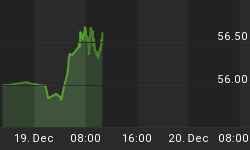The American economy is beginning to feel the pressure of the European crisis. However, decisions taken in Brussels last week could restore confidence and calm the financial markets for a few months. As result stocks and the euro could climb again.
Sell the rumor, buy the news?
The renewed optimism following last week's meeting in Brussels can support the S&P 500 index to 1400 and eventually to 1550. During the past weeks, the U.S. market held up nicely despite world stocks falling due to worries about the European crisis. It can now resume the medium-term uptrend, as the Relative Strength Indicator (RSI) signals extreme oversold conditions. It is true, the U.S. economy is stalling and the Federal Reserve could provide more help in the coming months. On a three-month basis, durable goods orders were down 14.5% in May. New orders fell 7.4%, while the pace of increase in unfilled orders is decelerating. This anticipates a decline in manufacturing activity shortly. Nonetheless, housing is bottoming and oil prices are declining for now. In May, new home sales increased by 7.6%, bringing the three-month moving average up to 353,000, the best score in two years. It will now take between three and five years from the bottom (2010) for prices to reach new highs, if history repeats itself.
People are afraid of investing in the real estate market again. The shock has been too strong and there is no easy fix. The huge debt must be reduced and it will be a top priority for the next Administration. The U.S. dollar can then possibly start a new bull market that will last between five and seven years. Patience is required, but we are moving toward the last part of the crisis. Since 1900, the Dow Jones Industrial (DJI) topped three times (1929/1965/2000). The following periods of consolidation (bear market) continued for 13 to 17 years, top to bottom (1906-1921, 1929-1942, and 1965-1982). Within these lateral movements, the DJI topped/bottomed roughly every 4 to 5 years. How would past history fit with today's events? The market reversed in 2000 and in 2008. It bottomed in 2002 and in 2009. A new top could be expected in 2012-2013, which might coincide with a bottom of the unemployment rate. The so called "fiscal cliff" scenario could contract growth next year.
Euro zone: It is not too late.
Europe is in recession and the European Central Bank (ECB) should soon cut its rates. Nonetheless, last week, after a few intense days of negotiations, the leaders of Europe took another step in the right direction. First, a single banking supervision entity will be created. Second, European Financial Stability Facility (EFSF) and European Stability Mechanism (ESM) will be used more efficiently. The EMS will be able to capitalize banks directly instead of passing these costly loans onto governments. This should stop the vicious spiral between banks and governments that has hit nations since the beginning of the European crisis. In addition, leaders wrote a document that anticipates a tighter fiscal and political union than is currently in place. In contrast with the past, it addresses most issues at the same time in order to overcome the differences between France and Germany.
France wants solidarity above all else, however, Germany expects sovereignty to be abandoned first. Additionally, states will not be allowed to issue debt without the consent of fellow European partners. A finance ministry will be set up to impose fiscal policies. Risks could then be shared throughout the Union by the issuing of financial instruments, such as bonds. Finally, political integration among European states is expected. Will words finally be transformed into actions? Time will tell. The report will be finalized in October and should be adopted in December. Until then, eur/usd can increase toward 1.34 and eventually 1.48. Seasonally, the second half of the year is not favorable to the U.S. dollar, considering also the extreme overbought conditions shown by some indicators. As an example, futures funds have massively bet in favour of the greenback, according to the latest Commitment of Traders report. In the past, this anticipated important turning points.















